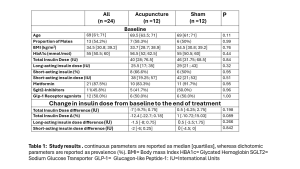Aims: We tested the possible effect of acupuncture on insulin sensitivity by assessing the variation in the insulin need in people with type 2 diabetes mellitus (T2DM). Methods: This is an interim analysis of a randomized, single-blinded trial (NCT04076800) evaluating the effect of acupuncture versus sham. Endpoints were the differences between the treatment and control groups in the variation of total daily insulin dose, delta (Δ) of insulin dose, basal insulin dose, and prandial insulin dose from baseline. Patients with T2DM were included, if they were in therapy with >10 UI of insulin analogues, and BMI >25 kg/m2. The dose of non-insulin glucose-lowering drugs was maintained stable during the treatment period. Before treatment, patients underwent a four-week run-in period, in which insulin was titrated, to maintain stable glucose levels. Acupuncture and sham treatment were administered twice a week for 3 months. Acupuncture treatment included use of somatic points (SP6; ST36; KI3; CV4; CV12; TE5; LI4; LI11; YinTang; ST28; BL23; BL22; BL20; BL13) and auricular points (most tender point on palpation with pressure feelers of 400 g on Stomach, Endocrine, Spleen, Kidney, Hungry, Shen man and Pancreas auricular points). Sham acupuncture will be applied distal from acupuncture points and areas used for treatment, with shallow insertion and without manipulation of the needle (15 needles in total on thorax, abdomen, back, arms and legs). Every week, during the treatment period, insulin was titrated according to self-monitoring blood glucose. Results: Out of 31 subjects who underwent randomization, 24 patients (12 on each arm) completed the treatment; median age was 69 years, median BMI was 34.5 kg/m2, median HbA1c was 55 mmol/mol; 54.2% were males. At the end of treatment, median insulin dose variation was -7 [-9.75; 0.75] UI in the acupuncture arm and +0.5 [-6.25; 2.75] UI in Sham (p=0.198). Total insulin dose Δ was 12.4% [-22.7%; 0.18%] in the Acupuncture arm, and +1% [-10.72%; 15.03%] in Sham (p=0.089). Long-lasting insulin dose variation was -1.5 [-8; 0.75] UI in acupuncture and +0.5 [-3.5; 1.75] in Sham (p=0.266), whereas fast-acting insulin variation was -2 [-6; 0.25] UI and 0 [-4.5; 0] U, respectively (p=0.842) No severe adverse events occurred. Conclusion: an interim analysis on a small sample showed a small and nonsignificant trend toward a reduction in the insulin dose after three months acupuncture therapy, in people with diabetes mellitus.


